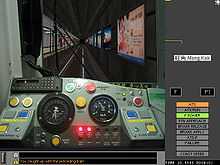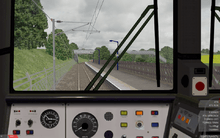BVE Trainsim
| BVE TrainSim | |
|---|---|
 Screenshot of a Class 323 (BVE 4) | |
| Developer(s) | Takashi Kojima (Mackoy) |
| Publisher(s) | Takashi Kojima (Mackoy) |
| Distributor(s) | Takashi Kojima (Mackoy) |
| Designer(s) | Takashi Kojima (Mackoy) |
| Platform(s) | Windows 95 Windows 98 Windows ME Windows 2000 Windows XP Windows Vista (With .dll add ons & BVE 5) Windows 7 (With .dll add ons/Windows XP Mode & BVE 5) Windows 8 (not supported) |
| Release date(s) | BVE TS 2: 2001 BVE TS 4: 2005 BVE TS 5: 2011 |
| Genre(s) | Train simulator |
| Mode(s) | Single-player |

BVE Trainsim (originally Boso View Express[1][2][3]) is a Japanese three-dimensional computer-based train simulator.[3] It is notable for focusing on providing an accurate driving experience[3][4][5] as viewed from inside the cab, rather than creating a network of other trains[6][7] —other trains passed along the route are only displayed as stationary objects.[3] BVE Trainsim was designed and developed by Takashi "Mackoy" Kojima[8] starting in 1996[3] with the original program name coming from the Japanese 255 series multiple unit trains found in routes in Japan.
Although the internal working of the BVE Trainsim program itself cannot be modified, additional routes and train cab views can be added[4][5] via a number of text-based configuration files.[6] Route builders have produced over 300 additional routes for the program, along with matching cab environments. Routes built by independent developers simulate rail activity in Asia, North America, South America, and Europe.[9]
BVE Trainsim 1
BVE Trainsim 1 was released in 1996 as an Alpha version under the name Boso View Express[10] and 1999 as a Beta Version. This version, the first version of BVE to be produced, had an interface that was similar to BVE Trainsim 2, but did not have a logo. Instead, the official symbol of BVE up until the release of BVE 2 in 2001 featured the words: 暴走 VIEW EXPRESS.[11]
BVE Trainsim 2
The first stable version released in 2001. BVE Trainsim 2 featured ATS and ATC. The latest version of BVE 2 is ver. 2.6.3 which was released on 27 March 2004.
BVE Trainsim 3
Unreleased and later cancelled, BVE Trainsim 3 was originally started in 2003 as an improvement over BVE Trainsim 2, but was eventually stopped due to problems encountered with development of the aforementioned program.[11]
BVE Trainsim 4
BVE Trainsim 4, released in 2005, added support for plugins to simulate train safety systems other than ATS and ATC. Because of the cancellation of version three, this was the first follow-on stable version since version two. It also has better graphics than BVE 2 with the latter being a major update. The latest version of BVE 4 is ver. 4.2.1947.25355 which was released on 1 May 2005.
The London Transport Museum used BVE Trainsim 4 to provide a simulation platform, within a mock underground rolling stock of the London Underground 1996 Stock,[12] before later porting to openBVE in 2010.
BVE Trainsim 5
BVE Trainsim 5 was officially released on 5 September 2011 as the successor to BVE 4. In July 2008, the developer had stated that he was rewriting BVE Trainsim from scratch because the previously released versions (BVE 2 and BVE 4) do not work with DirectX 9, and that the new version would support Windows Vista and Windows 7.[13] The first BVE 5 version (ver. 5.0.4265.3690) features a new format for storing train routes and route dependencies and a redesigned interface including a distance to next station indicator and a passenger comfort indicator, whereas the latest version (ver. 5.2.4523.37820) was released on 20 May 2012 and improves on versions 5.0 and 5.1 by including an indicator showing the number of passengers, adding simulation of trains shaking from side to side when passengers embark and disembark, and other improvements. The BVE 5 download page also includes a route converter which can convert BVE 4 routes into a format recognised by BVE 5.
openBVE

openBVE is an independently developed open-source train simulator. Although the name and logo were originally based on BVE Trainsim, openBVE is free and open-source software developed and written from scratch. It features support for train exteriors, animated 3D cab environments and animated scenery. Internally, openBVE makes use of OpenGL for rendering, as well as OpenAL for three-dimensional positional audio.
The program is noted for its cab ambiance and realism.[14] It is currently distributed in the public domain,[15] along with full C# and C source code.[16]
References
- ↑ Lew, Alexander (2007-12-17). "The Best Free Train Simulator". Autopia (Wired News). Archived from the original on 4 May 2009. Retrieved 2009-05-04.
- ↑ BVE Train Simulator(archive), The Simon Tonekham Statesman blog
- ↑ 3.0 3.1 3.2 3.3 3.4 "Announcing Boso View Express (BVE)". Train Simmer. 2001-02-26. Retrieved 2009-08-14. "Boso View Express (BVE) is a freeware 3D train simulator ... under development since 1996. ... nor does it offer dynamic scenery (moving trains). It does feature ... trains that react accurately"
- ↑ 4.0 4.1 "Microsoft Train Simulator". CBS Interactive. 2005-01-03. Retrieved 2009-08-14. "BVE ... physics are comparable with the real trains. ... Plenty of routes and trains are available free too!"
- ↑ 5.0 5.1 Baum, Peter. "Mechanik/ BVE". Retrieved 2009-08-14. "the trains actually rock back and forth and lean into turns ... has still remained popular due to its superior sound, train handling characteristics, and its easily modifiable components."
- ↑ 6.0 6.1 Barten, Alfred (2005). "Virtual Railroading/Train Simulation FAQs". Retrieved 2009. "BVE is built linearly. There is no opportunity to branch, unless the branched version is treated as a second route. ... BVE routes can also be built using Notepad"
- ↑ Hanstater, David. "Editorial: BVE Train Simulator". Atomic Systems IP. Retrieved 2009-08-14. "BVE is much smaller ... the only view is straight forward through the cab window. There are no outside views"
- ↑ http://mackoy.cool.ne.jp/trifle/me.html linked 2007-01-12
- ↑ http://www.bve.cz/en/home.html
- ↑ http://translate.google.com/translate?js=n&prev=_t&hl=en&ie=UTF-8&layout=2&eotf=1&sl=auto&tl=en&u=http%3A%2F%2Fmackoy.cool.ne.jp%2Fnote%2Fhistory.html. Retrieved 2011-03-20.
- ↑ 11.0 11.1 http://bve.i-circle.net/bve-trainsim/history. Retrieved 2009-09-25.
- ↑ "London Transport Museum BVE tube simulators.". Retrieved 2012-06-08.
- ↑ "BVE Trainsim 5 の開発について". Retrieved 2009-05-09.
- ↑ http://www.rockpapershotgun.com/2009/03/22/openbve-the-sim-now-approaching-platform-pc/ linked 2009-05-06
- ↑ Cabot, Toby (2009-06-29). "Train Simulator". Savannah (Free Software Foundation) (Latest News). Archived from the original on 2009-06-29. Retrieved 2009-08-16. "... and http://trainsimframework.org/ which is public domain"
- ↑ "The Official openBVE Homepage: Downloads".
Further reading
- Barten, Alfred (2006). This Is V-scale. ISBN 1-4276-0738-8.
- BVE Wiki
External links
- (Japanese) Official website
- openBVE